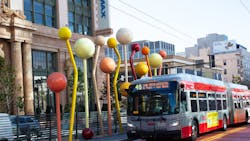SFMTA’s Muni Metro ridership up in 2023
Ridership grew on San Francisco Municipal Transportation Agency’s (SFMTA) Muni Metro in 2023, with an average weekday ridership of 433,000.
Before the COVID-19 pandemic, SFMTA looked at crowding data in two-hour windows. Currently, the agency looks at crowding data in 15-minute increments.
SFMTA notes its 75 miles of transit lanes and Quick Build projects are speeding up buses and trains. SFMTA transit operators now have real-time information about how close they are to the bus in front of them.
The agency increased its shelter cleanings by 50 percent in 2023. SFMTA has been using Fix It Week, which runs once a quarter, to keep shelters clean. The agency says that prior to launching Fix It Week, maintenance windows were short and it was difficult for crews to complete work efficiently, leading to ongoing maintenance challenges because Muni Metro maintenance can only take place when service is not running.
SFMTA says subway service is more reliable than it’s been in decades:
- Major subway delays have fallen 76 percent since 2019 and short delays are down 89 percent
- Across all agency vehicles, the distance between mechanical failures is up 10 percent since 2022
- Headway adherence – evenly spaced buses and trains – is up six percent since 2022
SFMTA is trying to bring up ridership on downtown commute trips, as the agency notes the trips were once the backbone of Metro Muni’s ridership, but the shift to remote work and downtown’s recovery being slower than the agency expected has caused the trip to not be needed as much.
According to the agency, ridership on the 14R Mission Rapid is up to 106 percent of 2019 levels on weekdays and 117 percent on weekends. It’s one of five lines now exceeding their pre-pandemic ridership, along with the 22 Fillmore.
In its most recent ridership survey, SFMTA says 66 percent rated Muni Metro service as “good” or “excellent”, a nine-point increase from 2021. The survey data also shows 71 percent of Muni Metro riders approve of the job the SFMTA is doing.
